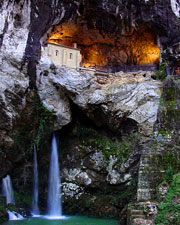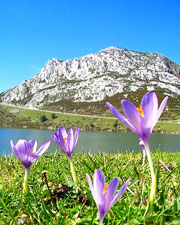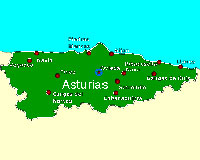|
Practically a country unto itself, no other region of Spain boasts such a vibrant history, landscape, and culture, as does Asturias. Bordered in the south by some of the most rugged mountains in the world, and to the north by the rich waters of the Bay of Biscay, the fertile valleys that make up Asturias truly are the Garden of Eden.

The Rich History:
The richness of Asturias did not happen by chance, but rather is the result of centuries of history in combination with the richness in geography. With its origins in pre-history, the roots of Asturias’ history may be traced back to Paleolithic era where the cave paintings in Ribadesella may still be visited to this day. During the iron-ages, the Celts chose to colonize Asturias and build impressive hill-forts such as those shown in the ruins that may be visited in Coaña. Even the Roman Emperor Agustus saw the appeal of Northern Spain and conquered the region in around 29 BC and setting up cities such as those at the ruins of Castro de Campa Torres. While these histories are interesting in their own right, the real romanticism of Asturias’ history doesn’t begin until much later.
The true legend and romanticism of Asturias begin with the Battle of Covadonga in 722. Back then most of Iberia had been conquered by the Moors, and although the Spaniards were not slaves or prisoners, they were no longer under Christian rule. Legend has it that the Moorish leader Al-Kama demanded the surrender of the region. Upon the peoples refusal to surrender, the Muslim armies charged into the narrow valley but were greeted by a rag-tag force of just a few hundred soldiers who had been hiding in a cave. As the story would have it, the small group led by Don Pelayo miraculously received a sign from the Virgin Mary indicating that the time was right. With the passion of God in their hearts, this small group was able to expel the advancing army and push them as far back as the mountin peaks in Leon, never to return to the region again. While this battle may have seemed insignificant to the Moors at the time, the real impact was that it gave Asturias its autonomy. Asturias was now its own kingdom, free from muslim rule and a refuge for Christian nobles to start the reconquista. No other factor has had such an impact on Spain’s history that of the conquest by the Moors from 700-1492, and no other factor had an influence on the expulsion of the moors more than that of the liberation of the kingdom of Asturias. When visiting Asturias, a must on every Itinerary is to visit the historical battle sites and religious hotspots of Covadonga.

The Rich Pastures:
The Picos de Europa in southern Asturias is not only a geological marvel full of towering peaks, cascading rivers, and mountain lakes, but it is also a culinary paradise. The rugged limestone mountains naturally filter the rainwater and impart it with valuable minerals which trickle down to the mist covered valleys below. These fertile lands make the ideal place for growing apples to make cidra, chestnut trees for producing honey, and most importantly, to grow the corn that is fed to the sheep, pigs and cows of the region. The livestock of this region is some of the best of all Spain, and the local menu always includes such entrees as ternera al cabrales (Steak with Blue Cheese) and Fabada Asturiana (Bean stew with chorizo and sausage.) Perhaps the best representation of this marriage between food and geography is with Cabrales and Valdeon Cheese, where the fresh milk from the local livestock is fermented and cured in the natural limestone caves to create some of the richest blue cheese in the world.
This last summer when visiting the Asturias we made it our mission to search out the finest product that best captured the spirit of this fertile region. We were fortunate when we came across the small farmers cooperative of Cata Gourmet. From their small factory they utilize only local organic ingredients to craft all-natural fruit preserves made from only two ingredients, local organic fruit and organic sugar. While we truly love these fruit preserves, we also accidentally stumbled upon another one of their products that just we just had to bring back to share with you. Behind their fruit orchards are rolling hills covered with wild mountain heather and chestnut trees that, following a brief visit from the local bees, end up as the richest and most complex honey we have ever tasted. The dark honey from the mountain heather and the creamy honey from the wild chestnut trees truly is the best we have found anywhere. We really hope that you enjoy tasting this honey as much as we enjoyed discovering it in this wonderful region of Spain.
Perhaps it is the naturally limestone-filtered water, or perhaps it is just the romanticism for Asturias that we hold in our heart, but to us the food from Asturias just tastes better. ~Marcos
|

|